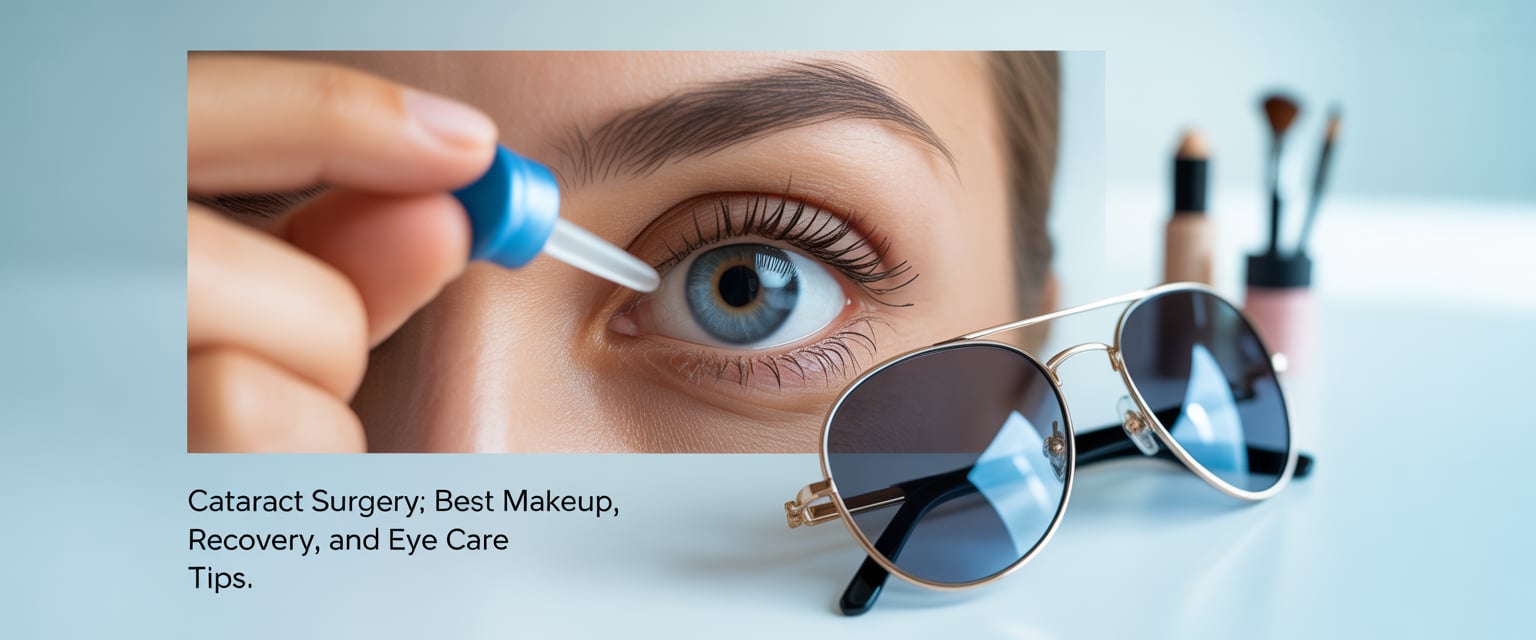Preparing for cataract surgery can feel overwhelming, especially when trying to understand the right steps for healing, eye care, and post-surgery routines. This guide on Buffalo Cataract Surgery: Top Makeup & Eye Care Tips is designed to make the process easier, clearer, and more comfortable for patients.

Whether someone is choosing the best recovery practices or learning how to safely reintroduce makeup, the right information can significantly improve results. By following expert-backed advice, this Buffalo Cataract Surgery: Top Makeup & Eye Care Tips article helps readers protect their vision, heal confidently, and make informed decisions every step of the way.
Buffalo Cataract Surgery: Top Makeup & Eye Care Tips
Cataract surgery restores clear vision and can greatly improve daily life. Whether someone is exploring options for cataract surgery in San Antonio, learning about the best multifocal lenses for cataract surgery, or comparing cataract eye surgery costs, understanding each step helps them make confident decisions. The best outcomes come from knowing how to care for the eyes before and after surgery, from choosing the right surgeon to selecting safe eye drops and protective sunglasses.
After surgery, small choices can make a big difference in recovery. Knowing the best eye makeup after cataract surgery, safe exercises, and the best over-the-counter eye drops supports healing and comfort. Patients in places like Buffalo, Fort Worth, or those considering care at the Alliance Vision Institute LASIK & Cataract Eye Surgery center can benefit from learning what to expect and how to protect their results.
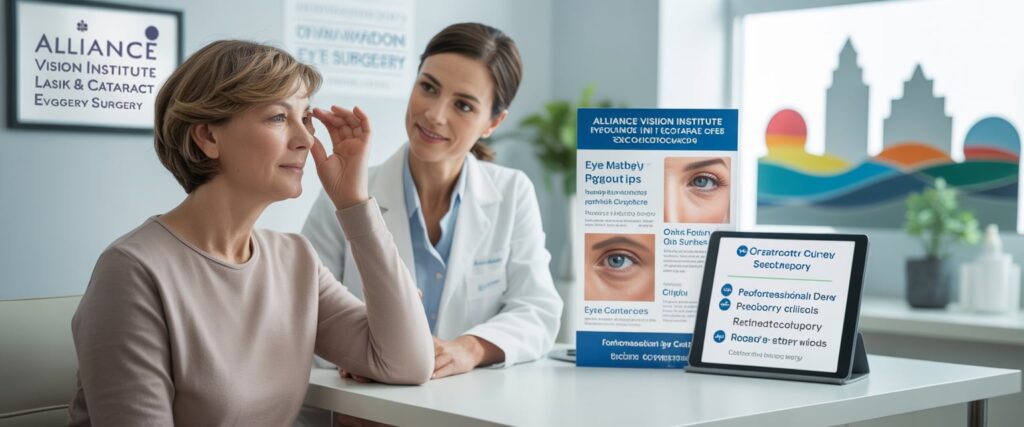
Each person’s experience is unique, and honest cataract surgery reviews and recovery tips can guide others toward better outcomes. From understanding eye lens replacement options to finding out if facilities like the Sheridan Wyoming VA do cataract surgery, this guide offers practical insight for anyone preparing for or recovering from cataract surgery.
Good eye care after cataract surgery helps prevent infection, reduce irritation, and protect healing tissue. Patients can return to normal routines gradually by following medical advice and using safe products for vision comfort and protection.
What to Expect After Cataract Surgery
Most patients experience mild discomfort, light sensitivity, and blurry vision for a few days. These symptoms usually improve as the eye heals. An ophthalmologist often prescribes medicated eye drops to control inflammation and prevent infection.
Patients should avoid rubbing their eyes or exposing them to dust and water. Protective eye shields may be worn at night to prevent accidental contact.
Activities like swimming and heavy lifting should be postponed for at least a week. According to GoodRx, avoiding strain and bending over helps maintain safe eye pressure during early recovery.

A follow-up visit allows the doctor to check healing progress and adjust treatment if needed. Most people notice clearer vision within a few days, though full recovery can take several weeks.
Timeline for Wearing Eye Makeup After Cataract Surgery
Eye makeup should be avoided for at least one to two weeks after surgery. Applying or removing makeup too soon can irritate the incision and increase infection risk. The Eye Mountain guide notes that preservatives in makeup can delay healing and cause discomfort.
Once cleared by the ophthalmologist, patients may begin with clean, hypoallergenic products. Brushes and applicators should be disinfected or replaced to prevent bacteria buildup.
Avoid waterproof mascara or eyeliner, as these require extra rubbing to remove. Gentle, oil-free makeup removers are safer for the healing eye.

If redness or irritation occurs, stop using makeup immediately and contact the doctor. Healing time varies by individual, so medical clearance is the safest indicator of readiness.
Choosing Safe Eye Makeup and Application Tools
After recovery, patients should use hypoallergenic, fragrance-free, and oil-free makeup. These products reduce the risk of irritation and allergic reactions.
A short list of safe practices includes:
- Replace mascara every 3 months.
- Avoid sharing makeup.
- Use clean brushes and applicators.
- Remove makeup gently with an oil-free makeup remover.
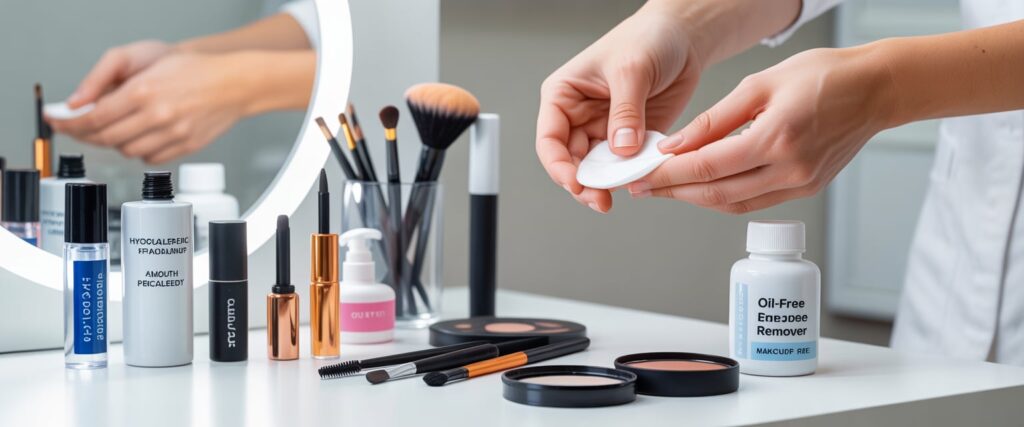
Avoid applying eyeliner inside the lash line, as it can block tear ducts and introduce bacteria. Patients with ongoing dryness can use artificial tears before applying makeup to improve comfort.
Regular cleaning of tools helps maintain eye hygiene and prevent infection.
Best Sunglasses and Eye Drops for Post-Surgery Protection
UV protection is essential after cataract surgery. Sunglasses with 100% UVA and UVB protection shield sensitive eyes from sunlight and glare. Wraparound styles offer better coverage outdoors.
According to Vision Center, wearing sunglasses helps reduce light sensitivity during recovery. Patients should also use prescribed eye drops as directed to prevent infection and control swelling.
For dryness, artificial tears or lubricating eye drops can relieve irritation. Choose preservative-free formulas to avoid further sensitivity.

A simple comparison table helps guide selection:
| Product Type | Key Feature | Purpose |
|---|---|---|
| Prescription drops | Anti-inflammatory / antibiotic | Prevent infection |
| Artificial tears | Preservative-free | Relieve dryness |
| Sunglasses | UV-blocking lenses | Protect from sunlight |
Consistent use of these protective measures supports faster, safer healing and long-term eye comfort.
Optimizing Results: Lenses, Surgeons, and Patient Experiences
Successful cataract surgery depends on precise lens selection, skilled surgeons, and informed patient choices. The right combination helps restore clear vision, reduce dependence on glasses, and improve long-term eye health.
Selecting the Best Multifocal Lenses for Cataract Surgery
Modern intraocular lenses (IOLs) offer options that correct multiple vision issues. Multifocal lenses allow patients to see clearly at near, intermediate, and far distances without constant use of glasses. Popular models include the AcrySof IQ Vivity, PanOptix Trifocal, and RayOne EMV lenses used at Buffalo Ophthalmology.
Each lens type has unique benefits.
- Standard IOLs restore distance vision only.
- Multifocal IOLs improve both near and far vision.
- Toric IOLs correct astigmatism.

An ophthalmologist reviews lifestyle needs, such as reading, driving, or computer work, before recommending a lens. Patients who drive at night may prefer lenses that reduce glare, while those who read often may favor near-vision optimization. Selecting the right lens ensures the best visual outcome and comfort.
Finding Top Cataract Surgeons and Eye Surgery Centers
Choosing an experienced cataract surgeon is critical. In regions like Buffalo, specialists such as Dr. Deepan Selvadurai at Buffalo Ophthalmology perform advanced “dropless” cataract procedures that reduce recovery time and medication needs. Patients can also explore listings of top cataract surgeons in Buffalo, NY or other major cities.
When comparing centers, patients should evaluate:
- Technology used – laser-assisted vs. manual methods
- Surgeon experience – years in practice and specialty training
- Post-surgery care – follow-up visits and recovery guidance
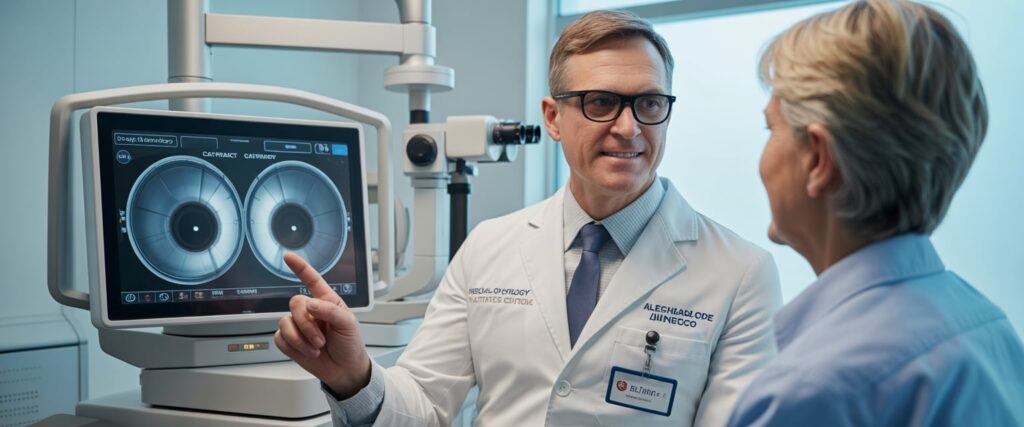
Facilities like Alliance Vision Institute in Fort Worth and clinics in San Antonio also offer advanced cataract and LASIK services. A well-trained ophthalmologist ensures both precision and safety during surgery.
Patient Reviews, Costs, and Real Surgery Videos
Patient feedback helps others understand real outcomes. Platforms like RealSelf share reviews describing recovery, cost satisfaction, and visual results. Most patients report improved clarity and minimal discomfort after surgery.
Typical cataract surgery costs vary by region, lens type, and insurance coverage. Standard procedures often cost less than premium multifocal lens options. Reviewing detailed estimates before surgery helps avoid unexpected expenses.
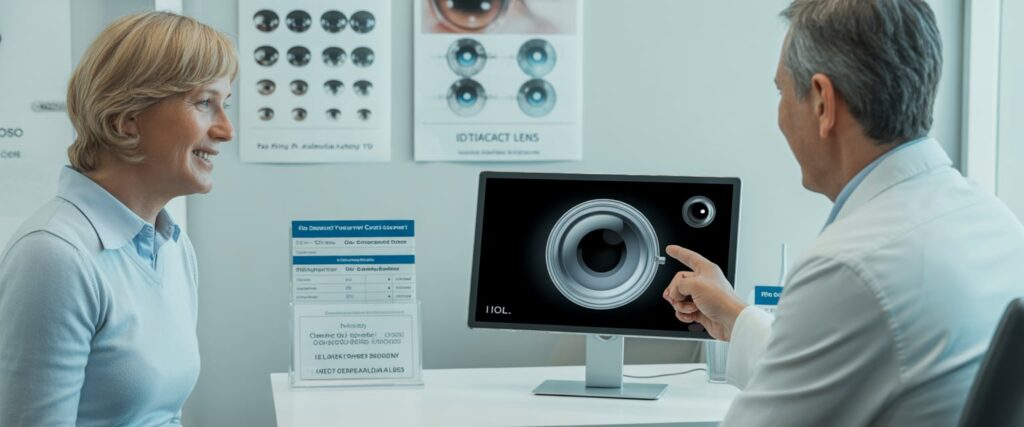
Watching a cataract eye surgery video can prepare patients for what to expect during the procedure. Educational content from trusted clinics shows how the cloudy lens is replaced with a clear IOL, helping patients feel more confident and informed before treatment.
Conclusion
Recovering from cataract surgery becomes much smoother when patients understand which habits support healing and which could slow it down. From safe makeup timelines to proper eye care routines, taking small steps can make a big difference in comfort and clarity. As highlighted throughout Buffalo Cataract Surgery: Top Makeup & Eye Care Tips, choosing the right lenses, eye drops, and protective products ensures long-term success. By following medical guidance and the insights shared in this Buffalo Cataract Surgery: Top Makeup & Eye Care Tips guide, patients can enjoy clearer vision and a healthier, more confident recovery journey.
Frequently Asked Questions
Patients recovering from cataract surgery benefit from careful eye care, proper product choices, and safe activity levels. Selecting qualified surgeons, high-quality lenses, and protective eyewear also supports long-term vision health and comfort.
What are the best practices for eye makeup application after cataract surgery?
After surgery, patients should wait at least one week or until their doctor approves before using any eye makeup. It’s safest to choose hypoallergenic, ophthalmologist-tested, and preservative-free products to reduce irritation and infection risk.
Avoid using old makeup or brushes, as bacteria can build up and cause complications. Cream-based products are safer than powders, and shimmer or glitter should be avoided. Learn more about safe post-op beauty routines at What Kind of Makeup Should I Use After Cataract Surgery?.
Which exercises are recommended following cataract surgery?
Light walking is usually safe within a few days, depending on the surgeon’s advice. Patients should avoid strenuous activities, bending over, or lifting heavy objects for at least one to two weeks.
Low-impact movement, such as gentle stretching or stationary cycling, can help maintain circulation without straining the eyes. Always follow the ophthalmologist’s specific recovery plan.
How do I find the best cataract surgery options near me?
Patients can start by searching online for board-certified ophthalmologists or cataract specialists in their area. Reading verified reviews and checking hospital affiliations can help identify trusted providers.
Many clinics, such as those offering cataract surgery in San Antonio, provide consultations to discuss lens options, costs, and recovery expectations.
What are the top-rated multifocal lenses for cataract surgery?
Multifocal lenses improve both near and distance vision, reducing the need for glasses. Popular choices include AcrySof IQ PanOptix, Tecnis Symfony, and RayOne Trifocal lenses.
The best lens depends on each patient’s vision goals, eye health, and lifestyle. An ophthalmologist can recommend the right lens after a detailed examination.
What should I consider when looking for the best cataract surgeon?
Patients should look for surgeons with extensive experience, positive patient outcomes, and access to advanced technology such as femtosecond lasers. Checking credentials and reading cataract surgery reviews can provide insight into patient satisfaction.
It’s also helpful to schedule consultations with more than one surgeon to compare recommendations and comfort levels.
Which sunglasses are recommended to protect eyes after cataract surgery?
After surgery, UV protection is essential to prevent light sensitivity and protect healing tissues. Patients should wear polarized sunglasses that block 100% of UVA and UVB rays.
Wraparound styles offer extra coverage from sunlight and wind. Many ophthalmologists recommend keeping sunglasses on outdoors for several weeks after surgery.
